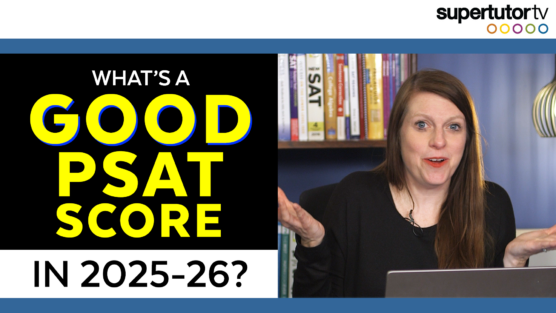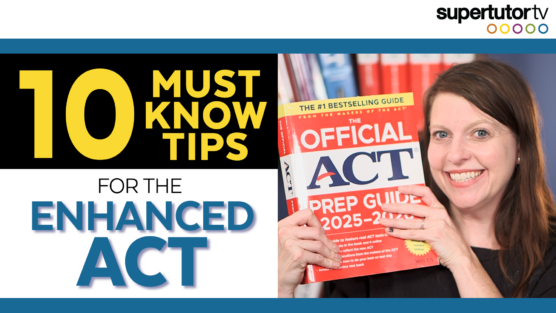Do you want to get a 36 on the ACT? Are you wondering how you can prepare yourself for the new enhanced ACT and get the best score possible? For over two decades, I’ve created an online course that students have used to prepare for a perfect 36 on the ACT, and you can check that out at supertutortv.com. So, we have a new version of the ACT coming out. How are you going to get a perfect score on that? I’m going to give you multiple tips in this video on how you can make that happen.
Know All the Grammar
My first tip is to know all the grammar. The English section is the easiest section to ace on the ACT. It is a content test. What that means is that if you learn the rules and you apply the rules, you can get all the questions right. It’s pretty straightforward. And whether that means you get a video course with someone like me, a book, or a tutor to help you learn all of those grammar rules, you need to learn the grammar rules for the ACT. Chances are you’re not just going to be able to dig up in your memory everything from seventh-grade grammar and get everything right. You need to learn all of these rules up and down, backwards and forwards, so that you’re using the rules, not your ears. You’re not just feeling it out. And that is the path to a 36. Pretty straightforward section. And then you also want to be doing practice tests to lock in all of that grammar knowledge.
Treat the Math Section Like a Final Exam
Number two, I want you to treat the math section like it’s for final exams. Imagine that you had a final exam for geometry, algebra two, pre-calc, and statistics all on the same day. Welcome to the math section of the ACT. In order to be prepared for this test, you need to know the content. Again, just like the English section, this is a content-based test. It’s not an IQ test. They want to know if you know math. From what I’ve heard, you will need to know formulas, whether that’s the volume of a sphere or the surface area of a cone or the law of sines. All of the formulas that you’ve been responsible for on the old ACT, my new advice is to memorize them. The old ACT used to sometimes give you the formula, which made things easier on some types of questions. My inkling is that since they’ve shortened the test and given you more time per question, they’re going to have to make the questions hard in some way. And one way that they can make them hard is by making you learn all of the formulas and bring that outside knowledge to the test. So, that’s my best advice. We have a formula cheat sheet. If you want to check it out, check out our cheat sheet at supertutortv.com. There are some other goodies there too: math calculator programs, for one. But basically you want to prep all this content. You need to know how to do every type of problem for each type of question. I have math books that I go through that cover to cover. Those are good resources if you’re trying to learn everything in the math section.
Be Precise on the Reading Section and Go Back and Forth
Three, the ACT reading section. One of the biggest mistakes that I see students make on the ACT reading section is they think they can read the whole passage and then just answer the questions. I fully realize that that’s how you approach reading comprehension in class and at school. There, it’s a closed-book test, but this is an open-book test. And the number one thing that you should be doing to get a 36 on the reading section is quickly mapping the passage, reading a question, figuring out where to go back, and finding the exact answer. Being precise by going back and forth and back and forth and back and forth is the number one way that most of my students are able to get 36s on the ACT. Is it possible that you have the memory of an elephant and can memorize the whole passage by doing a slow read and then going through the questions quickly? It’s possible, but 99% of my students can’t do that. They don’t have memories like that. Maybe you do. But for normal human beings, the best way to approach this and be super precise is to go back and forth and back and forth and back and forth. So that’s my biggest tip: you’ve got to learn to move quickly, but be thorough and double-check your work. The reading section is a very straightforward test. If you can get good at this, if you can practice like crazy, you can make a 36 happen.
Practice the Science Section as Much as Possible
For the science section, one way to get a 36 on the ACT is to skip the science section now. But jokes aside, how do you get a perfect score on the science section? My number one piece of advice again, just like for the reading section, is to practice the section as much as possible. Is there outside information on it? Maybe a little bit, and that can make it hard to score a 36 section score on the science, I think, more than any other section because science is so broad and there are only two content questions per test. Not very many, at least at this point. The science section is essentially like a reading comprehension section with charts and graphs where you’re seeking information and going back and forth between the question and the passage, or between the question and the data. And to me, science is more about information retrieval than actual science knowledge. Can you be precise? Can you make sure you don’t lose any detail, and can you process complex kinds of scenarios to that end?
Use your pencil. I definitely recommend taking it on paper, especially if you’re doing the science section, because then you can underline every little detail as you go through the question. I have some other tips for the science section as well on our channel that you can check out. But practice, practice, practice. Be precise, pay attention to all the little things, learn to work systematically, and don’t read the passage first. Probably 80 to 90 percent of my students don’t read the passage first. It’s not wrong to read the passage first, but usually it’s more efficient if you head to the question and figure out what you’re looking for.
Take as Many (Real) Practice Tests as Possible
Fifth tip: take as many practice tests as possible, ideally real practice tests. Now one issue that we have is that with the enhanced ACT there are only going to be so many official practice tests that are available. You can use old ACT tests, which question by question are probably very similar to the new test. So my recommendation is to save the enhanced tests for the end of your prep. And at the beginning of your prep, practice from older ACTs just so you get really good at all the question types and so that you understand how to approach ACT reading, ACT science, and ACT math. You can get everything down, and then you can kind of adapt to the format as you approach the test more nearly. And hopefully, ACT will continue to release the “Preparing for the ACT” packet that was released for the old test as well. There are probably several of those also floating around for free on the internet somewhere. However, ACT has been cracking down on people sharing those, and they have removed the older versions from their website. If you have an older brother or sister who downloaded their “Preparing for the ACT” packet, that might be another source where you can find that.
Take the Enhanced ACT on Paper
Number six, my final piece of advice is to take the enhanced ACT on paper. Winners take the test on paper. There are a lot of habits and skills you can use within test taking that you need to do on paper in order to get the most out of them, such as underlining, circling, using the process of elimination, drawing on the diagram, measuring, etc. These kinds of tips that I often teach as a tutor are much easier to do with paper and pencil than on a screen. As you learn to do more of these techniques as opposed to just being a passive test taker, your ability to do well on paper may increase, specifically on the kinds of questions that might require processing or really digging into details or information.
I hope you guys like this blog and that it was helpful!




